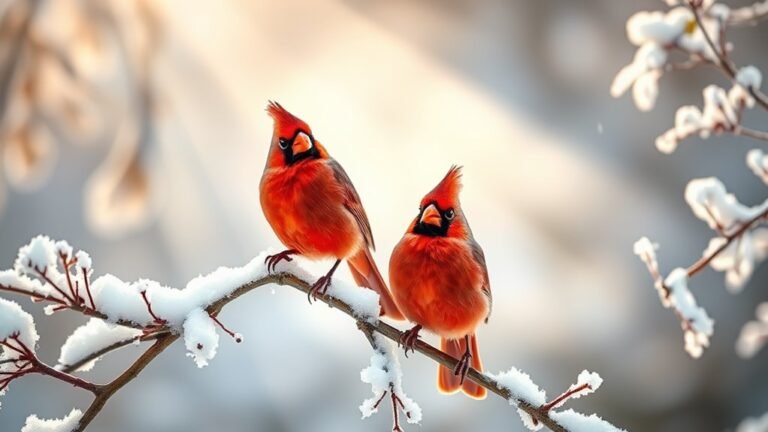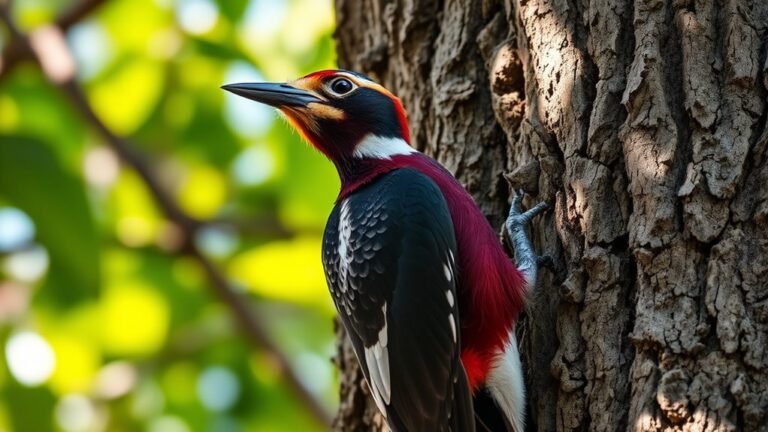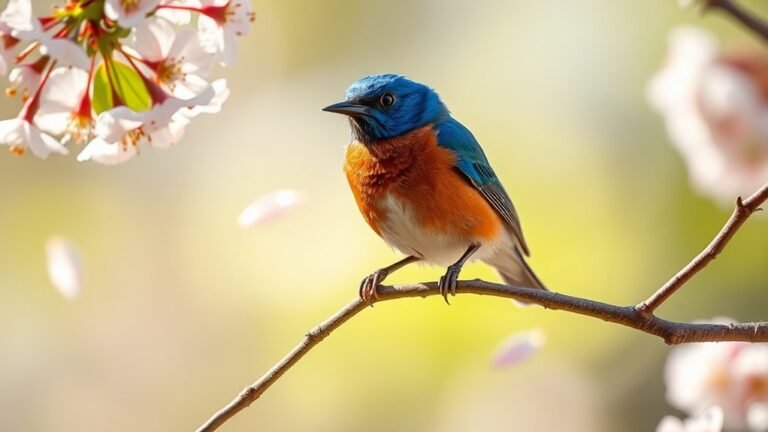15 Birds With Orange Beaks: Identification Guide
Birds use their beak colors to communicate and find food. The bright orange beaks of these 15 birds serve important functions in their lives. For example, the Atlantic Puffin's beak helps it dive for fish, while the American Oystercatcher's beak is perfect for its life along the coast. Learning about these beaks can help you understand their habits and the ecosystems they live in. This knowledge is vital for bird conservation efforts.
Key Takeaways
- The Atlantic Puffin has a bright orange beak. It uses this beak to catch fish while diving in the North Atlantic.
- The American Oystercatcher has a bold orange beak. This beak is great for prying open shellfish on sandy beaches.
- The Caspian Tern has a striking orange beak. This beak helps it catch fish during its dives.
- The African Fish Eagle features an orange beak. It is known for its sharp vision when hunting near water bodies in Africa.
- The Roseate Spoonbill has orange accents on its bill. It uses its unique bill to forage for crustaceans and small fish in coastal wetlands.
Atlantic Puffin

The Atlantic Puffin is a colorful bird known for its bright orange beak. This bird lives mainly in the North Atlantic and nests on coastal cliffs and islands.
Puffins are social animals that form large groups, especially during breeding season. They perform interesting courtship rituals, such as bill clapping, to strengthen their pair bonds.
Puffins are skilled divers and catch fish with ease. Their homes are found on rocky shores and grassy areas, which provide safety from predators.
Learning about puffins helps us understand their important role in the ecosystem and appreciate their unique behaviors.
Roseate Spoonbill
The Roseate Spoonbill is a colorful bird found in wetlands and marshes, especially in warm coastal areas.
These birds thrive in their habitats, where they find plenty of food. The Roseate Spoonbill uses its distinctive spoon-shaped bill to search for crustaceans, small fish, and other aquatic life.
This feeding method shows how well they fit into their environment. As you watch them wade through shallow waters, their bright plumage adds to the beauty of their feeding behavior.
Learning about the Roseate Spoonbill can deepen your appreciation for bird diversity and the ecosystems they inhabit.
American Oystercatcher
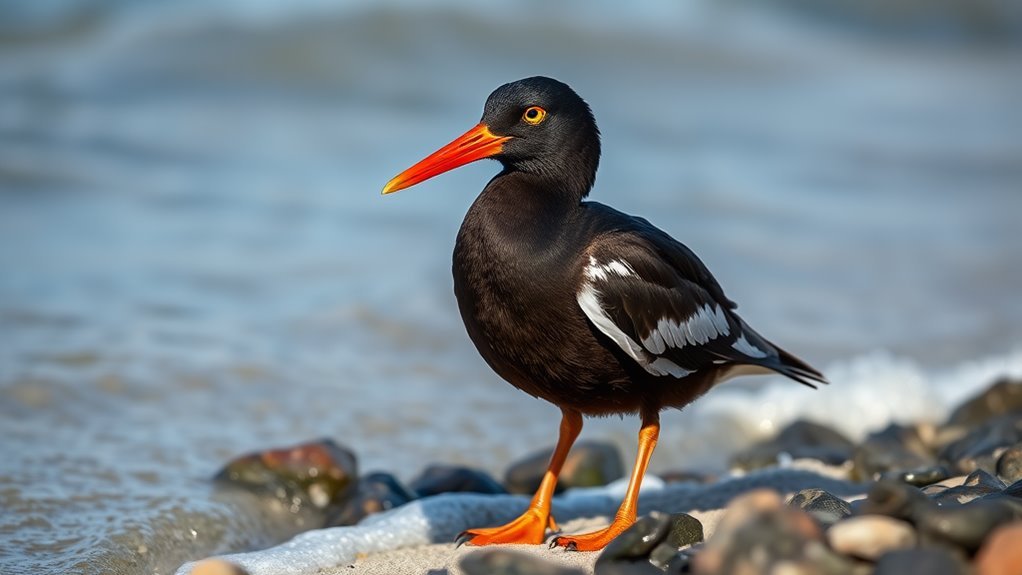
American Oystercatchers are striking shorebirds with bold orange beaks.
These beaks are essential for their foraging. You can find them in coastal areas like mudflats, sandy beaches, and estuaries.
Watching their behavior shows how adaptable they're and how they interact socially.
Here are three interesting facts about American Oystercatchers:
- They use their beaks to pry open shellfish, demonstrating their skill.
- They often forage in pairs or groups, showing their strong social connections.
- They typically nest on sandy ground, which highlights their ability to thrive in their environment.
Common Tern
The Common Tern is an impressive bird known for its hunting skills. It dives into the water to catch small fish, which is its main food source. With excellent eyesight, the Common Tern can spot fish from above, showcasing its agility.
During migration, these birds travel long distances. They move from colder northern areas to warmer southern regions.
This journey highlights the need to protect their habitats along the way. By learning about the Common Tern's feeding and migration, you can better understand its role in the ecosystem.
Observing these birds fosters a deeper connection to nature and encourages conservation efforts for the future.
Caspian Tern
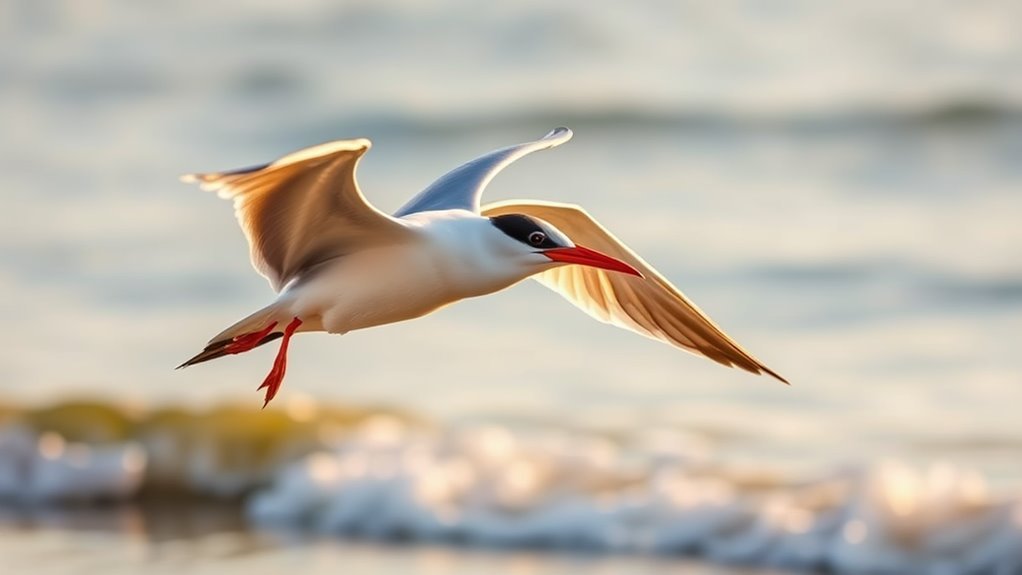
The Caspian Tern is a large bird known for its size and appearance. It has a bright orange beak and long wings, which help it stand out in coastal areas.
- Observe how it dives accurately to catch fish, showing its strong hunting abilities.
- Listen to its unique calls, which create a lively sound along the shore.
- Recognize its role in conservation, which is important for healthy ecosystems.
Caspian terns prefer to nest on sandy beaches and islands. During the breeding season, they display interesting behaviors.
Their diet mainly consists of fish, which they catch during migrations. Learning about the Caspian Tern's habitat and habits helps us connect with and appreciate this fascinating bird.
Great Horned Owl
The Great Horned Owl is a powerful nocturnal predator. It thrives in various habitats, including woodlands and urban areas, showing great adaptability.
This owl hunts by flying silently, allowing it to surprise small mammals and birds. It nests in tree cavities or abandoned structures, keeping its young safe.
The Great Horned Owl has a distinctive call that echoes at night. Watching its silhouette against the moon creates a strong connection to nature and highlights the balance of ecosystems where these amazing birds live.
Black Skimmer
The Black Skimmer is a bird known for its black and white feathers and its orange bill. It skims the water's surface to catch fish. This behavior is impressive and showcases its hunting skills. The Black Skimmer prefers habitats like sandy beaches, estuaries, and coastal areas.
Here are three interesting features of the Black Skimmer:
- Unique Beak: Its beak helps it catch fish effectively.
- Social Nature: It often travels in large groups, showing strong social bonds.
- Nesting Preferences: It chooses open areas for nesting, highlighting its adaptability.
Learning about the Black Skimmer helps us understand its role in the ecosystem and the importance of preserving its habitats.
Orange-billed Sparrow
The Orange-billed Sparrow is a captivating bird found in grasslands and open woodlands. It forages for seeds and insects in the underbrush.
This sparrow moves carefully, often hopping between low perches while checking for danger.
Orange-billed Sparrows usually form small flocks. This behavior encourages social interaction within their groups.
Their bright orange bills stand out and reflect their lively personalities. Observing their actions can enhance your birdwatching experience.
Masked Booby
The Masked Booby is an eye-catching seabird known for its unique features. It has a bright orange beak and a distinctive black cap. Learning about its habitat and feeding habits can enhance your appreciation for this species.
- The Masked Booby nests in isolated coastal areas, often on steep cliffs or rocky surfaces.
- It feeds by diving at high speeds to catch fish, demonstrating impressive agility.
- Observing their social behavior in colonies gives seabird enthusiasts a sense of connection and community.
The Masked Booby showcases the beauty of marine life and offers a memorable experience for those who watch it.
Coral-billed Ground Cuckoo
The Coral-billed Ground Cuckoo is a unique bird that lives in dense tropical forests. It prefers areas with thick underbrush, which provides shelter and food.
This bird forages on the ground, searching for insects and small animals. It's known for its low, rhythmic calls, which add to its mysterious nature.
Studying its behavior can enhance your understanding of bird ecology. Connecting with other bird watchers about this cuckoo can create a sense of community, allowing you to share insights and experiences about this fascinating bird.
Northern Shoveler
The Northern Shoveler is a fascinating waterfowl. This duck lives in shallow wetlands and marshes. It has a broad, spatula-shaped bill that helps it filter food from the water.
Here are some notable features:
- The male Northern Shoveler has vibrant green plumage on its head, which attracts attention.
- Its bright orange beak adds to its visual appeal.
- These ducks are social animals, which promotes interactions among different species in wetland areas.
Learning about the Northern Shoveler's behavior shows how it forages for food and performs courtship displays.
This knowledge enhances your appreciation for these birds and connects you to nature.
Rose-breasted Grosbeak
The Rose-breasted Grosbeak is a beautiful songbird known for its vibrant colors and melodic calls. You can find these birds in wooded areas, often near gardens and backyards, where they thrive in mixed deciduous and coniferous trees.
During breeding season, male grosbeaks display their bright pink and black feathers while singing to mark their territory. They build nests in shrubs or low trees, where females typically lay three to five eggs and incubate them for about two weeks.
Learning about their habitat helps improve your birdwatching experience and supports conservation efforts. Sharing this interest fosters community and deepens your connection with nature.
African Fish Eagle
The African Fish Eagle is a recognizable bird of prey. It has a bright orange beak, a white head, and a dark brown body. This eagle lives near lakes and rivers in Africa, where it finds its food.
Here are some interesting facts about the African Fish Eagle:
- Distinctive Call: The eagle makes a loud, memorable sound that many associate with freedom.
- Excellent Vision: It can see fish from high in the sky, allowing it to hunt effectively.
- Cultural Importance: Many people admire this eagle as a symbol of strength and resilience.
Habitat loss poses a threat to these eagles.
Conservation efforts are essential for protecting their future. By supporting these initiatives, you can help safeguard their habitat and contribute to wildlife preservation.
Eurasian Curlew
The Eurasian Curlew is a shorebird known for its long, curved bill and distinctive appearance.
These birds live in coastal areas, wetlands, and grasslands. They prefer habitats like mudflats, where they search for crustaceans and insects. The curlew uses its bill to probe the mud, skillfully extracting food.
Curlews often forage alone, but they form small flocks during migration. Their calls reveal their social interactions.
Learning about their behavior can help you connect with these birds and improve your birdwatching experience.
Scarlet Macaw
The Scarlet Macaw is a colorful bird found in the tropical rainforests of Central and South America.
This bird lives in areas with tall trees and plenty of fruit. Its diet includes nuts, seeds, and fruits, which attract the attention of many bird lovers.
Here are some emotional connections to the Scarlet Macaw:
- Watching their playful behavior brings happiness.
- Seeing their bright colors in nature inspires wonder.
- Learning about their social habits builds a sense of belonging among birdwatchers.
Explore the beauty of the Scarlet Macaw, and enjoy its vibrant presence.
Frequently Asked Questions
What Habitats Do Birds With Orange Beaks Prefer?
Birds with orange beaks prefer wetland environments and forest ecosystems. These habitats provide ample food and safe places to nest. The availability of resources in these areas supports their survival and helps them raise their young successfully.
Are Orange Beaks a Sign of Health in Birds?
Orange beak color can show the health of birds. Bright colors usually mean good nutrition and strong vitality. However, to really understand their health, you should also look at their habitat and behavior. These factors give a fuller picture of their well-being.
How Do Orange-Beaked Birds Care for Their Young?
Orange-beaked birds care for their young with strong parental involvement. They build nests and take turns incubating their eggs. After the eggs hatch, both parents feed and protect their chicks. This teamwork helps ensure their young grow up successfully.
Do All Birds With Orange Beaks Migrate?
Not all birds with orange beaks migrate. Their migration depends on food availability and climate. Some birds adapt to their local conditions. Others may change their diet, which affects their movement and seasonal behavior.
What Is the Significance of Beak Color in Bird Mating?
Beak color is important in bird mating. Bright beak colors can show health and good genes. Birds with colorful beaks attract more mates. This increases their chances of reproducing successfully. The brightness of a beak can signal to potential partners that the bird is fit and ready to mate.

Ava is a bird enthusiast and nature lover who has spent countless hours observing and learning about the fascinating world of birds. With a passion for sharing her knowledge and inspiring others to appreciate the beauty of birds, Ava writes about her experiences and insights on avianadmirer.com.



